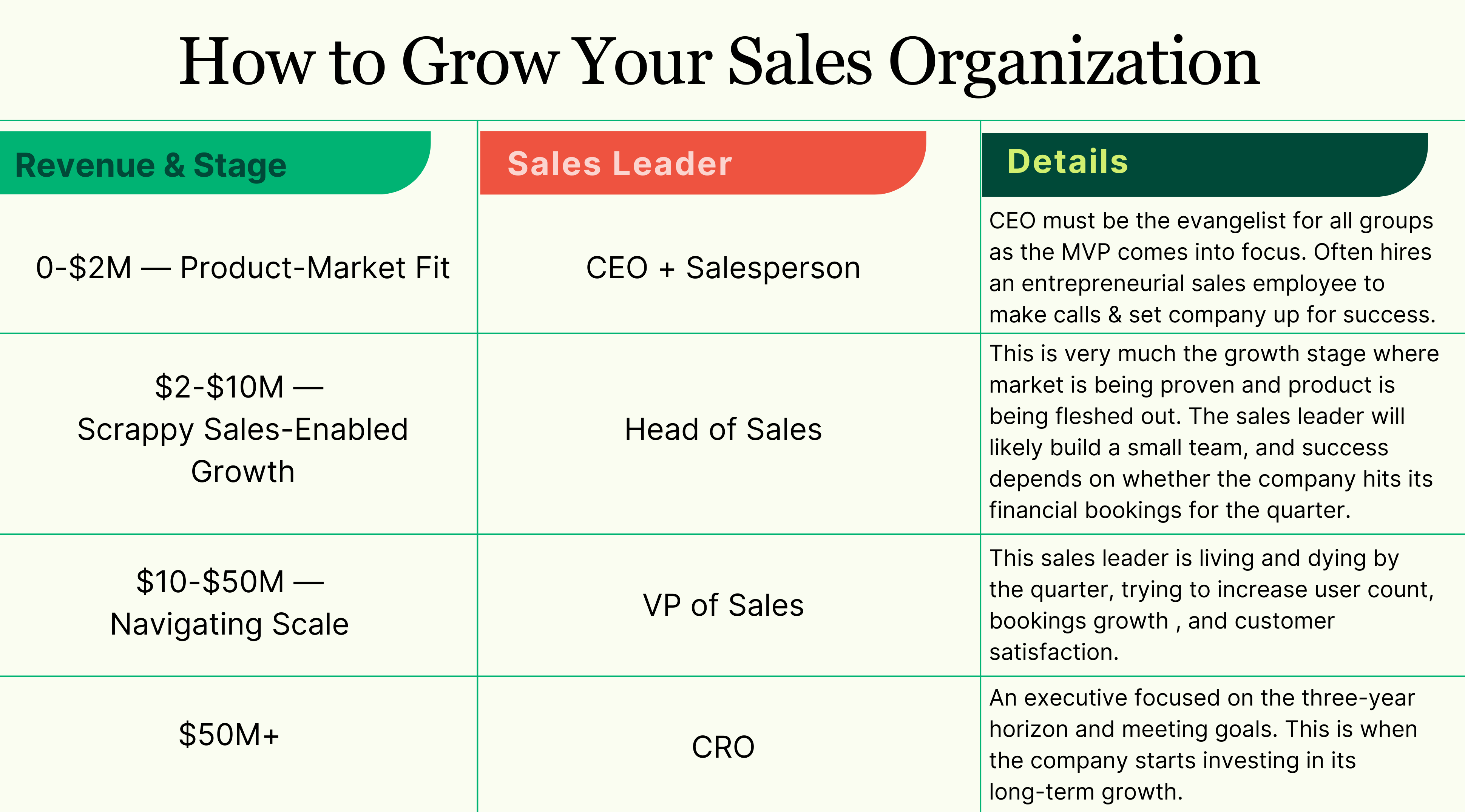It is widely understood that revenue growth is crucial to the success of a startup. But at what point should a startup be thinking about long-term revenue growth and, in turn, hire a chief revenue officer? The CRO role has, of late, become a bit of a fad with very early startups, but often this doesn’t actually work out. I joined DocuSign as one of the first sales leaders and grew into the CRO role over a decade — and I have been advising and observing how startups approach the gritty issues of building a sales organization. I believe that CROs are incredibly valuable if hired at the appropriate time in a company’s growth cycle. While there are times that having a CRO on board early can be helpful to a startup’s long-term growth (see the exception below), for many startups, there is such thing as too early.
A CRO should not necessarily be a company’s first sales leader — nor should it be their first executive leadership hire. Some experts say that hiring a CRO early proves to investors that the company has a plan for revenue growth in place and is ready to execute on a plan to achieve sustainable profitability. But I believe there are three crucial stages a startup needs to go through before bringing on a CRO: finding product-market fit, scrappy sales-enabled growth, and navigating scale.
$0 – $2 million — Finding product-market fit
At the very early stage — $0-$2 million — the CEO needs to be the evangelist for the vision of the company, the product, and the customers. They work closely with potential customers, establish user testing, and ask meaningful, open-ended questions. In short, the CEO leads sales, marketing, development, and recruiting! At this stage, the entire small team should be maniacally focused on building a product and establishing product-market fit.
The CEO might bring on a smart entrepreneurial salesperson excited about starting from scratch and building something. But this is not necessarily a head of sales. It is someone with an entrepreneurial spirit, a particular passion for the product and company, and someone that the CEO (and potentially other existing executives) feels can help set the performance orientation and culture of the GTM organization for the future.
At this stage, the entire small team should be maniacally focused on building a product and establishing product-market fit.
This early salesperson makes calls and talks to potential customers — someone who works directly with product and engineering, so they know what they will eventually be trying to sell inside and out. This is about the time that I started at DocuSign. I was in the trenches every day. I had to understand what prospects were telling me, and at the same time, I had to understand what we had and what we were going to have in the future, so I could use that information as part of the narrative I had with my customers and prospects. By the way, you don’t always need expensive consulting firms to help you find your lane. Many times, the answers are right under your nose: your customers.
$2-$10 million — Scrappy Sales-Enabled Growth
To move through the $2-$10 million range — that’s when a startup needs a clear sales leader. People call this role many things — sales director, head of sales, etc. Whatever you call it, the role is the same — a scrappy sales leader who can stretch the boundaries and the art of the possible to start achieving some growth. To do this, this leader will likely build a small team, and success depends on whether the company hits its financial bookings for the quarter. This is the time to begin to formulate a point of view around organizational design. For example, how does one think about segmentation? Does it make sense to carve out some specific verticals? Are there potential partners that can help bring the product to market? I remember this also being a time at DocuSign where we began to build out customer advocacy groups — deciding which notable wins we could use to amplify our value proposition and brand. Many of those same early customers should be viewed as some of an organization’s most valuable assets. They will teach you. They will spread market awareness, and they also happen to contribute to your early financial success – treat them well!

$10-$50 million — Navigating Scale
Once a startup hits $10 million in revenue, it becomes more important that they consider hiring an experienced VP of sales — someone who knows how to scale up to that $50 million mark. This sales leader is living and dying by the quarter, trying to increase user count, bookings growth, and customer satisfaction. But just because a startup makes that hire, it should never check that box and move on. Always be recruiting — never stop networking. It helps founders understand their current base of talent and capability. It can help you identify blind spots. You should constantly talk to sales leaders so that when you do need someone, you don’t have to start from scratch.
While the early sales team sets that early culture for your startup, at this stage, it is critical to hire more people who know how to scale a company. That doesn’t mean you need to replace your initial team. In fact, I’d strongly guide against that as they were critical to your foundational culture. Those early hires have tribal knowledge and can often move into new roles and augment new hires’ work. Build a culture and environment where these two groups can work flawlessly together as a team.
$50 million and above — Long-term revenue growth
When a startup hits that $50 million mark, that’s the time to start paying attention to long-term durable revenue for the business rather than focus solely on in-quarter booking achievements. This is the juncture where startups need a more seasoned sales executive, a chief revenue officer, to join the team. At this point, the company clearly has product-market fit, they’ve scaled successfully with a great team, and there are separate organizations within the company dedicated to building product, selling, customer satisfaction, etc. This leads to a shift in expectations inside a company — the leaders need to understand how they will durably grow next year — not just next quarter.
A CRO takes a holistic view of the company and is responsible for the long-term revenue expectations of the business and thinking around the bend multiple quarters out. They identify likely expectations for annual and multi-year growth and the quarterly changes required to achieve those targets. They are responsible for the sales organizational design, often encompassing a marketing arm, inbound sales, account executives, customer success, and sometimes solution consulting. Hiring a CRO brings in a different level of business acumen and planning.
The right investors recognize there are important stages before focusing on long-term revenue growth.
The BIG exception
While finding product market fit, early sales-led growth, and scaling are the three stages that usually precede hiring a CRO, the exception I see to this is a young startup that is growing significantly. If a startup is at, say, $10 million in revenue, but they’re growing at a rate of 300% a year, then hiring a CRO could be a good investment. That person can build the infrastructure, processes, and methodologies the company needs to be well positioned when they quickly hit that $50 million mark – and beyond. This is where CEOs should follow their instincts and the instincts of the great advisers they have on their boards. Having people on your board who have seen it all and can recognize these stages and at what point you should be bringing on a leader like a CRO is critical to building a successful startup. There is no weakness in asking for help — a good board will give you good counsel.
Work with the Right Investors
Yes, investors are looking for startups that are going to be profitable. But at each stage of growth, you need the best leader that can get you to the next milestone in your journey. It is easy to get over your skis on big-shot talent. But early on, that may not be what you need. CROs are expensive — and not only that, they often have leaders and teams they want to bring with them, which are also very expensive and not necessarily the appropriate experience level needed. That is a quick way to burn through your capital before establishing product-market fit. The right investors recognize there are important stages before focusing on long-term revenue growth. At Madrona, we invest in a team and their vision from day one for the long run. We roll up our sleeves and work alongside you, providing strategy and experience to help founders and leaders build lasting and significant companies. Don’t hesitate to reach out.

